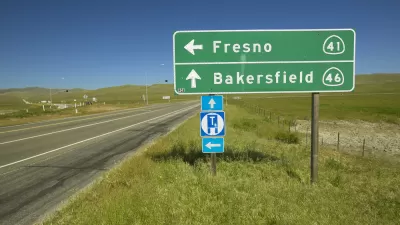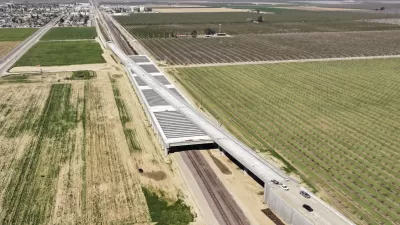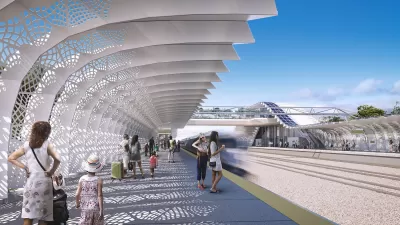With a train-friendly administration in Washington, supporters of the project hope that state leaders will make a stronger commitment to funding the full project.

California High-Speed Rail Authority (CASHRA) CEO Brian Kelly faced questions from state Assemblymembers in a joint hearing on March 10 as state leaders continue to debate the plan for building a 400-mile system connecting Southern California and the Bay Area via the Central Valley. As Melanie Curry reports in Streetsblog Cal, Kelly presented "the current business plan, which focuses on completing a usable 171-mile segment of electrified high-speed rail from Merced to Bakersfield," connecting some of California's fastest-growing cities.
With a more train-friendly administration in the White House, HSR supporters hope the project will benefit from federal funding that was withheld during the Trump administration. At the hearing, Louis Thompson, head of the High Speed Rail Peer Review Group, "urged the legislature to make a decision on whether it will commit to the project going forward," saying that the project "can never be managed without adequate and stable funding." In order to get the most out of the project, he said, the state has to show "ongoing commitment." Without a commitment to building the full system, warned Kelly, the state "will have spent $14 billion on a system that does not get you eighteen trips a day, that will be forced to share tracks with freight corridors, and will not bring an increase in ridership."
Since "the original bond funding was never meant to fully fund construction of a high-speed rail project from Los Angeles to San Francisco," writes Curry, it's time for the legislature to make concrete plans for securing the funding needed to build an effective HSR system.
FULL STORY: High-Speed Rail: It’s Time to Commit

Study: Maui’s Plan to Convert Vacation Rentals to Long-Term Housing Could Cause Nearly $1 Billion Economic Loss
The plan would reduce visitor accommodation by 25,% resulting in 1,900 jobs lost.

North Texas Transit Leaders Tout Benefits of TOD for Growing Region
At a summit focused on transit-oriented development, policymakers discussed how North Texas’ expanded light rail system can serve as a tool for economic growth.

Why Should We Subsidize Public Transportation?
Many public transit agencies face financial stress due to rising costs, declining fare revenue, and declining subsidies. Transit advocates must provide a strong business case for increasing public transit funding.

How to Make US Trains Faster
Changes to boarding platforms and a switch to electric trains could improve U.S. passenger rail service without the added cost of high-speed rail.

Columbia’s Revitalized ‘Loop’ Is a Hub for Local Entrepreneurs
A focus on small businesses is helping a commercial corridor in Columbia, Missouri thrive.

Invasive Insect Threatens Minnesota’s Ash Forests
The Emerald Ash Borer is a rapidly spreading invasive pest threatening Minnesota’s ash trees, and homeowners are encouraged to plant diverse replacement species, avoid moving ash firewood, and monitor for signs of infestation.
Urban Design for Planners 1: Software Tools
This six-course series explores essential urban design concepts using open source software and equips planners with the tools they need to participate fully in the urban design process.
Planning for Universal Design
Learn the tools for implementing Universal Design in planning regulations.
Ascent Environmental
Borough of Carlisle
Institute for Housing and Urban Development Studies (IHS)
City of Grandview
Harvard GSD Executive Education
Toledo-Lucas County Plan Commissions
Salt Lake City
NYU Wagner Graduate School of Public Service





























